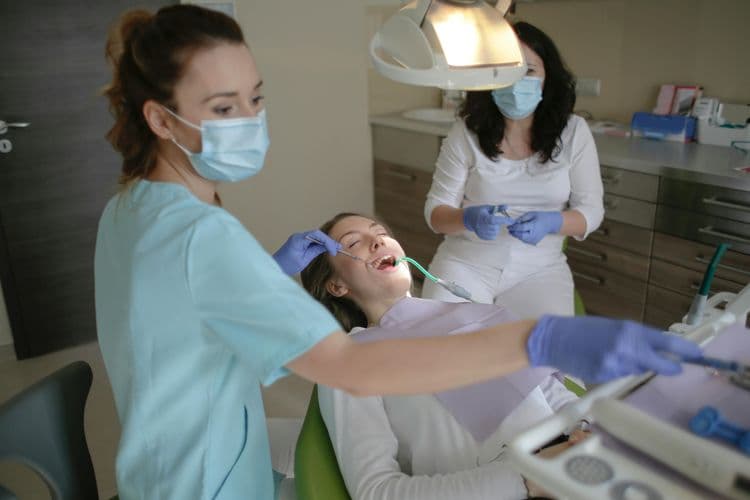Teeth whitening costs exhibit significant variability, influenced by treatment type and supplemental factors. In-office procedures by dental professionals, ranging from $300 to $1,000, offer immediate, substantial results. Conversely, at-home kits, priced between $20 and $150, provide a more economical alternative. Geographic location, dentist expertise, and individual needs further impact pricing. This variability necessitates a careful evaluation of cost-effectiveness and long-term benefits, prompting an exploration of the most suitable whitening approach.
Understanding Teeth Whitening Options
Understanding the various teeth whitening options is essential for making informed decisions about dental care. Teeth discoloration causes can be intrinsic or extrinsic, influenced by factors like age, diet, smoking, and medication. Clinical studies emphasize the importance of identifying these causes to tailor effective whitening strategies. Whitening myths debunked include the belief that all whitening solutions are identical in efficacy and safety. Evidence-based research highlights that over-the-counter products vary greatly in hydrogen peroxide concentration, impacting their effectiveness. In addition, the misconception that natural remedies suffice for ideal results is challenged by clinical data, which shows limited efficacy in removing deep stains. Professionals advocate for personalized assessments to determine the most suitable whitening approach based on individual discoloration patterns and dental history.
Professional In-Office Whitening Treatments
Professional in-office whitening treatments represent a highly effective solution for individuals seeking significant and immediate improvements in tooth color. These procedures are performed under the supervision of dental professionals, ensuring both safety and efficacy. In-office benefits include the use of high-concentration bleaching agents, which are not available in over-the-counter products. The controlled environment allows for ideal application, minimizing risks such as gum irritation or enamel damage.
The treatment duration typically ranges from 60 to 90 minutes, depending on the specific protocol and degree of discoloration. Clinical studies have demonstrated that professional whitening can achieve shade improvements of up to eight shades. This rapid transformation is attributed to the synergistic effect of potent bleaching agents and advanced light-activation technology, enhancing outcomes in a single appointment.
At-Home Whitening Kits From Dentists
At-home whitening kits provided by dental professionals typically contain custom-fitted trays and a peroxide-based whitening gel, optimized for safe and effective use. The application process requires adherence to specific instructions regarding duration and frequency to maximize efficacy while minimizing potential adverse effects. Clinical studies indicate that results from these kits can last between 6 months to a year, contingent on individual oral hygiene practices and dietary habits.
Professional Kit Components
A well-structured at-home whitening kit from a dentist typically includes custom-fitted trays and a professional-grade whitening gel, often containing carbamide peroxide or hydrogen peroxide as the active ingredient. Custom trays are meticulously crafted to fit the patient’s dental arch, ensuring ideal contact between the whitening agent and the teeth’s surface. This precise fit minimizes gel wastage and reduces the risk of gum irritation. Whitening gels in these kits exhibit higher concentrations of active ingredients compared to over-the-counter alternatives, consequently enhancing efficacy. Clinical studies substantiate the superior whitening results achieved through dentist-supervised kits, attributing them to the tailored approach and potent gel formulations. Therefore, these components collectively contribute to an effective, safe, and patient-specific at-home whitening experience.
Application Process Explained
The tailored components of a dentist-supervised at-home whitening kit necessitate a methodical application process to maximize efficacy and safety. This process begins with a thorough dental examination to customize the whitening trays, ensuring a precise fit. The application steps are essential, involving the precise placement of the whitening gel into the trays, followed by adherence to prescribed treatment duration. Typically, patients are advised to wear the trays for a determined period, often ranging from 30 minutes to several hours, depending on the concentration of the whitening agent. Clinicians recommend monitoring for sensitivity or adverse reactions throughout the treatment duration. Evidence-based protocols, including periodic evaluations by the dentist, are vital to optimize outcomes and minimize risks associated with teeth whitening.
Expected Results Duration
How long do the results last from dentist-supervised at-home whitening kits? The expected results duration of teeth whitening using these kits typically ranges from six months to two years. This variability is contingent upon several duration factors, including individual oral hygiene practices, dietary habits, and smoking status. Clinical studies indicate that adherence to recommended protocols, such as avoiding stain-inducing substances, can prolong whitening effects. The concentration of the whitening agent and the frequency of application also play pivotal roles in determining the longevity of results. Regular follow-up visits to the dentist may be advised to assess and maintain ideal outcomes. Ultimately, the durability of the whitening effect is influenced by both intrinsic and extrinsic factors, requiring personalized strategies for sustained results.
Over-the-Counter Whitening Strips and Gels
Over-the-counter whitening strips and gels represent a widely accessible category of dental products designed to enhance tooth aesthetics by reducing discoloration. These products typically contain peroxide-based compounds, such as hydrogen peroxide or carbamide peroxide, which facilitate oxidation-reduction reactions to break down chromogens on tooth surfaces. Clinical studies have demonstrated varying degrees of whitening effectiveness, contingent upon concentration and usage duration. However, safety concerns persist, particularly pertaining to potential enamel demineralization and gingival irritation. Adverse effects may be exacerbated by improper application or excessive use. The American Dental Association emphasizes adherence to manufacturer guidelines to mitigate risks. While over-the-counter options offer cost-effective alternatives to professional treatments, users must consider potential side effects and consult dental professionals for personalized recommendations.
Natural Teeth Whitening Methods
Can natural methods effectively whiten teeth while maintaining oral health integrity? Evidence suggests that select natural agents can contribute to teeth whitening. Baking soda, or sodium bicarbonate, is a mild abrasive that helps remove surface stains, enhancing enamel brightness. It also possesses antibacterial properties, contributing to oral hygiene. However, excessive use may erode enamel due to its abrasive nature. Activated charcoal is another natural substance employed for whitening. Its highly porous structure allows adsorption of extrinsic stains and toxins. Nonetheless, clinical data on its efficacy and safety is limited, and excessive use poses risks of enamel abrasion. Both methods offer cost-effective alternatives, yet require cautious application to prevent adverse effects on dental health. Further longitudinal studies are warranted to establish their long-term impact.
Comparing Costs of Different Whitening Options
When evaluating the financial implications of teeth whitening, it is essential to compare professional whitening treatments with at-home whitening kits. Professional treatments, often conducted in a clinical setting, typically incur higher costs due to the use of advanced technology and the expertise of dental professionals. In contrast, at-home whitening kits are generally more economical, although their efficacy may vary based on the concentration of active ingredients and user adherence to guidelines.
Professional Whitening Treatments
Although numerous teeth whitening methods are available, professional whitening treatments provide a more controlled and effective approach due to their use of higher concentration bleaching agents. This clinical option guarantees whitening safety by offering supervision from dental professionals, thereby mitigating risks such as enamel erosion or gum irritation. The treatment effectiveness of professional whitening is enhanced by customized trays and precisely formulated bleaching agents, which allow for uniform and significant color improvement. Comparative cost analysis reveals that professional treatments are typically higher priced than over-the-counter alternatives; however, they yield superior and faster results. Evidence supports that in-office whitening can achieve up to eight shades of improvement within an hour, underscoring its efficacy and potential as a preferred choice for individuals seeking ideal whitening outcomes.

At-Home Whitening Kits
At-home whitening kits offer a cost-effective alternative to professional treatments, utilizing lower concentrations of bleaching agents to enhance dental aesthetics. These kits generally contain carbamide peroxide or hydrogen peroxide, compounds known for their whitening effectiveness. Clinical evidence suggests that while at-home options may not achieve the immediate results of in-office procedures, they present a viable option for gradual shade improvement. Kits include custom-fit trays, strips, or LED lights designed for user convenience and varying budgets. Comparatively, at-home systems range from $20 to $150, considerably lower than professional interventions. Additionally, some individuals explore home remedies, although these lack empirical validation and may compromise enamel integrity. As a result, consumer discretion and adherence to manufacturer guidelines are paramount for ideal outcomes.
Factors Influencing the Cost of Teeth Whitening
The cost of teeth whitening is considerably influenced by a range of factors, including the type of treatment, the geographic location of the dental practice, and the expertise of the dental professional. Technological advancements in whitening procedures have introduced more efficient and effective methods, often resulting in increased costs due to the utilization of cutting-edge equipment and materials. Market trends also play a significant role, as demand fluctuations can impact pricing structures. Geographic location affects operational costs and subsequently the pricing, with urban areas typically presenting higher costs due to increased overheads. Additionally, the proficiency and reputation of the dental professional may command premium fees, reflecting their experience and success rates. These elements cumulatively shape the financial landscape of teeth whitening services.
Evaluating the Long-Term Value of Whitening Treatments
When considering the long-term value of teeth whitening treatments, it is essential to assess both the immediate and sustained benefits in relation to the financial investment required. Long term benefits include improved aesthetic appearance and enhanced self-confidence, which must be weighed against potential maintenance costs. Clinical studies indicate that professional treatments often provide longer-lasting results compared to over-the-counter products. However, the durability of outcomes is contingent upon individual oral hygiene practices and dietary habits. Regular maintenance, possibly involving periodic touch-ups, incurs additional costs that must be factored into the overall investment. Evidence suggests that the efficacy and cost-effectiveness of whitening treatments are maximized when maintenance protocols are adhered to, thereby optimizing both immediate and extended benefits relative to initial expenditures.
Tips for Cost-Effective Teeth Whitening Solutions
How can individuals achieve cost-effective teeth whitening results without compromising efficacy? An exploration of DIY whitening methods reveals budget friendly options that maintain clinical outcomes. Utilization of over-the-counter whitening strips, gels, or toothpastes offers a lower-cost alternative to professional treatments. These products contain carbamide peroxide or hydrogen peroxide in concentrations that have been clinically validated for safety and efficacy. Additionally, incorporating natural remedies such as baking soda or activated charcoal can serve as adjuncts to enhance whitening results without substantial financial investment.
Further, adherence to proper oral hygiene practices—brushing twice daily with fluoride toothpaste and regular flossing—can prevent extrinsic staining and prolong whitening effects. Evidence suggests that combining these approaches yields effective, economical whitening solutions, thereby optimizing both cost and outcome for individuals seeking brighter smiles.
Frequently Asked Questions
Are Teeth Whitening Procedures Covered by Dental Insurance?
Dental insurance coverage typically excludes cosmetic procedures, including teeth whitening. Clinically, whitening alternatives like over-the-counter products or natural remedies are prevalent. Evidence-based practices suggest these alternatives lack the efficacy of professional treatments but offer a cost-effective solution.
How Long Do Teeth Whitening Results Typically Last?
Teeth whitening results generally last between six months to three years. Longevity depends on individual teeth maintenance and use of whitening products. Clinical studies highlight that regular oral hygiene practices greatly influence the durability of whitening effects over time.
Can Teeth Whitening Cause Sensitivity in Teeth and Gums?
Clinical studies indicate that teeth whitening can elevate sensitivity levels in teeth and may cause gum irritation. The extent varies based on individual conditions and whitening methods, necessitating professional evaluation to mitigate potential adverse effects.
Are There Any Risks Associated With Teeth Whitening?
Teeth whitening, while offering cosmetic benefits, presents risks such as enamel erosion and gum irritation. Common teeth whitening myths often downplay these potential adverse effects. Clinical evidence supports caution and professional consultation before undergoing whitening treatments.
How Often Should I Whiten My Teeth for Optimal Results?
For ideal results, professional treatments should be limited to once every six months, while home remedies can be used more frequently, but with caution. Evidence suggests overuse may lead to tooth sensitivity and enamel erosion.


